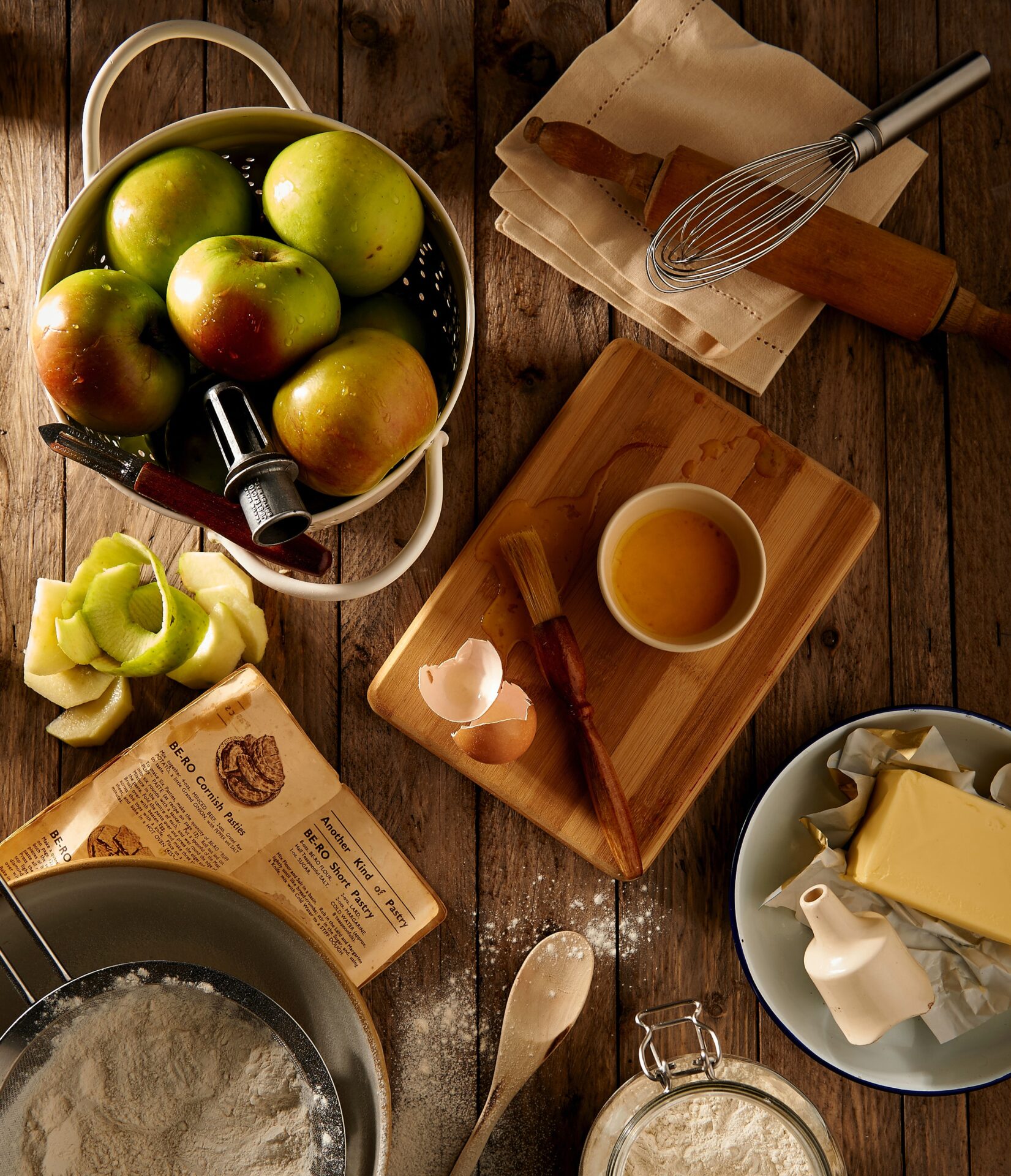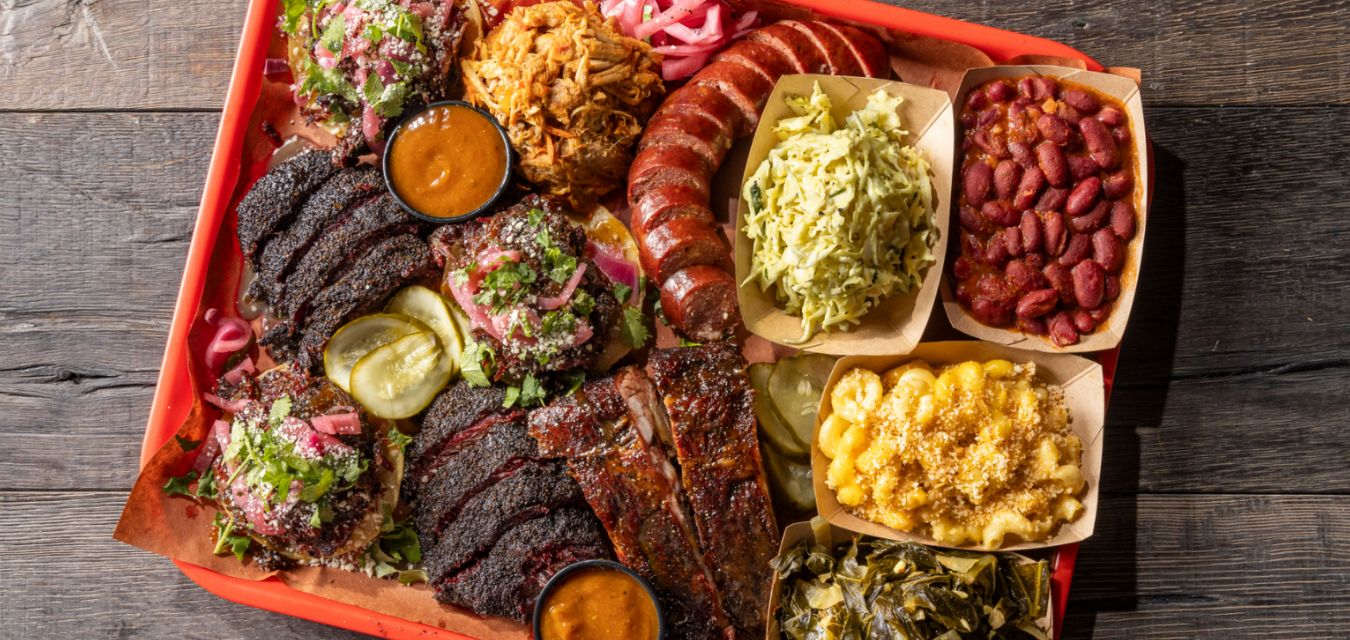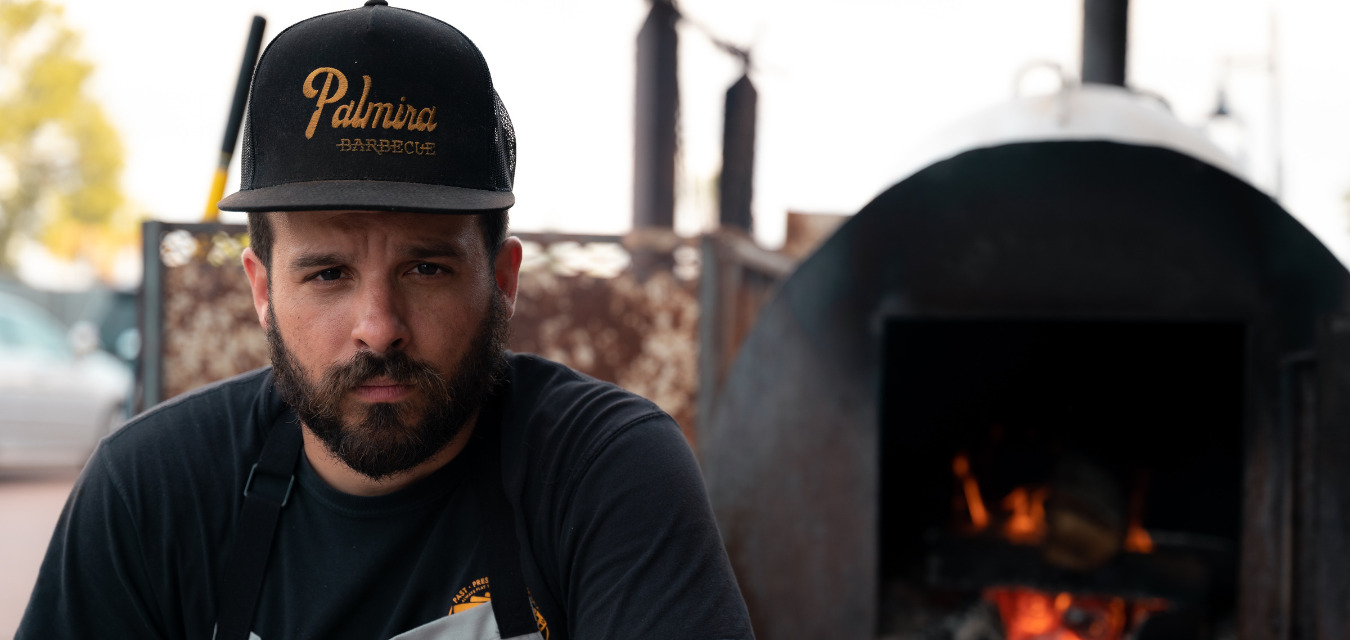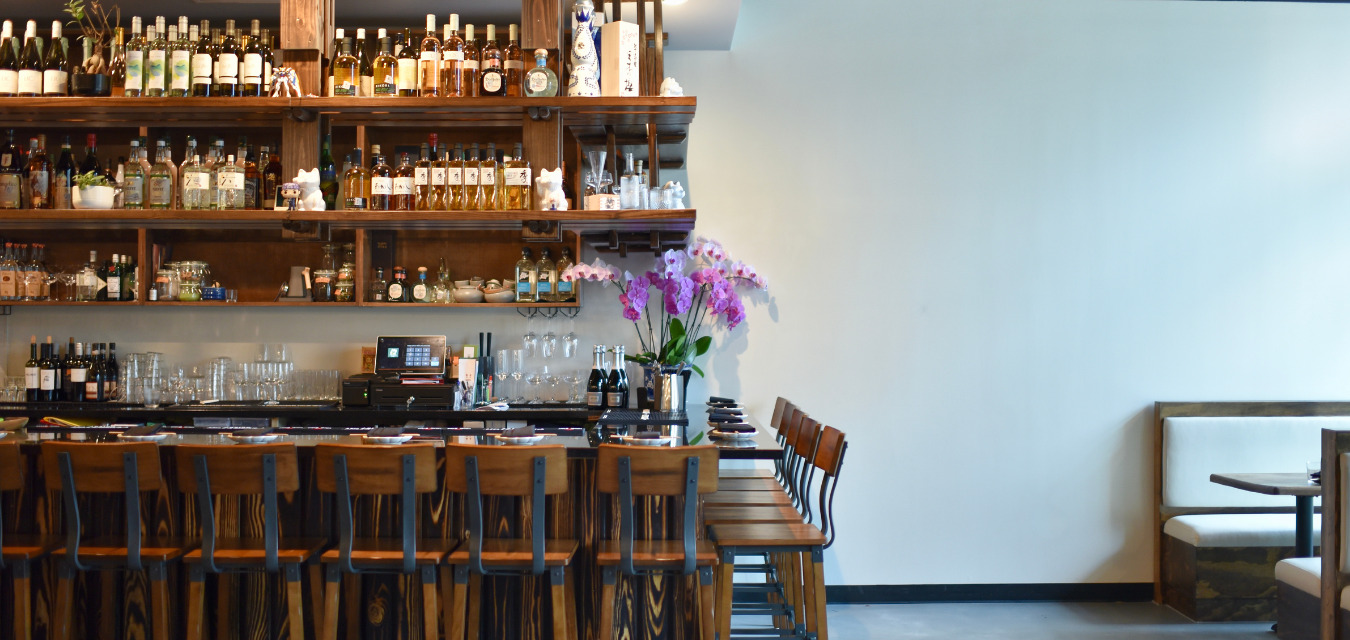Two Southern pitmasters from unlikely origins are spreading a new kind of barbecue gospel—from the Carolinas to Texas
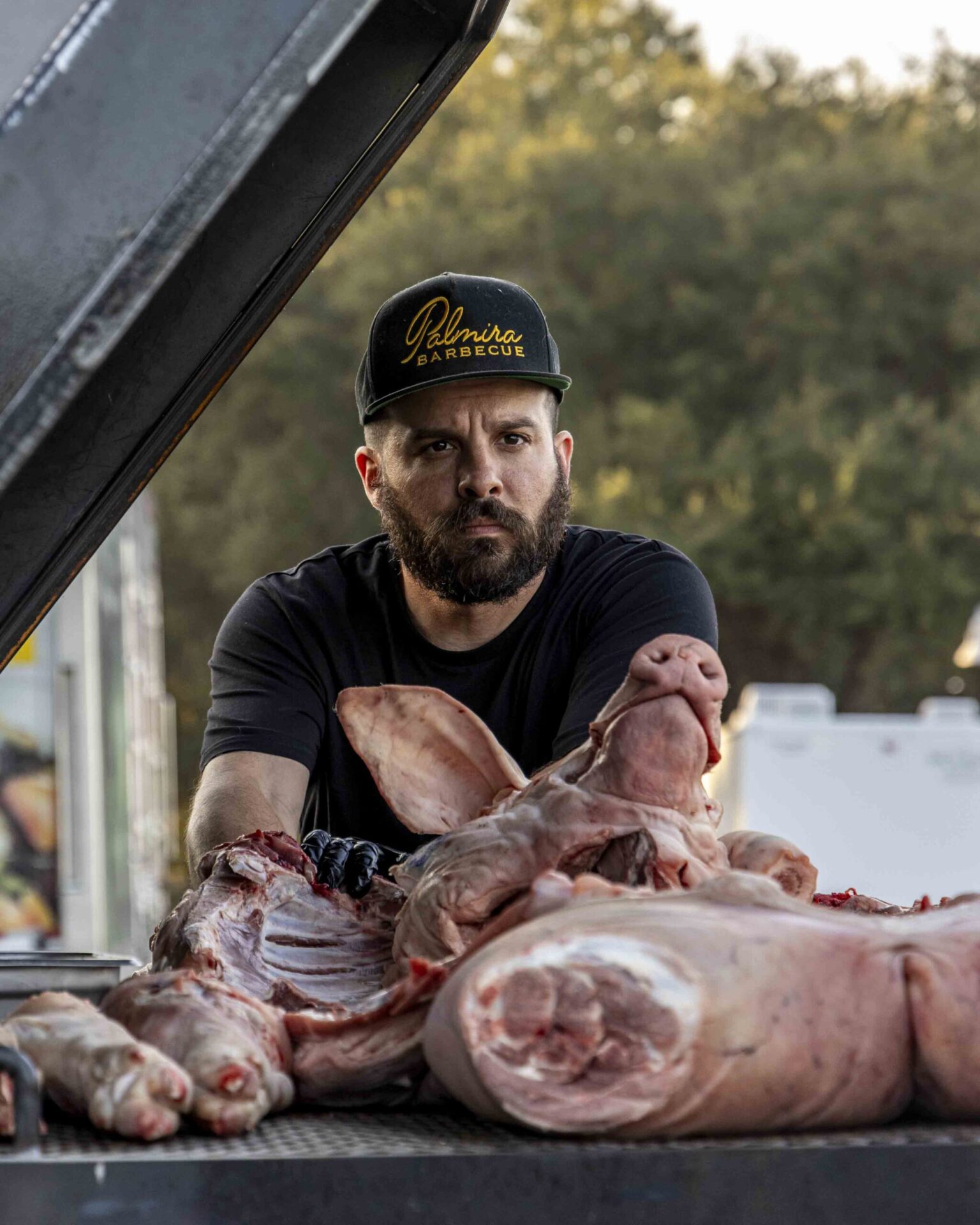
As thousands of barbecue fans were set to descend on Lockhart, Texas, the barbecue capital of the state, on November 4 and 5, 2023, more than a dozen pitmasters spent the wee hours of the morning filling the air with the heady scent of post oak and seasoned meats. Nearly all of them were prepping the Texas standards: brisket, hot links, beef ribs. All except for a couple of guys laboring over two open pits where the smells wafting out were distinctly different—fattier, headier, spicier. These two were cooking whole hog.
The unlikely renegades were Hector Garate of Charleston’s Palmira Barbecue and Don Nguyen of Houston’s Khói Barbecue. They were not the first to cook a whole hog at this particular festival—where brisket rules and the only seasoning to be found is salt and pepper—but theirs was, to many, the most memorable. They were serving at the BBQ World’s Fair, the first day of the fest, which celebrates globally inspired flavors from the newest wave of Southern pitmasters.
Nguyen—Vietnamese born, Houston raised—had cooked at the festival in the past, sharing his Vietnamese take on a Texas beef rib served with curry and rice. But this time, he had Garate on his team—a Puerto Rican who was raised in the Southeast and has become a student of true Carolina whole hog. Garate had flown in the night before, surprising Nguyen with his arrival, and would only stay until the last plate was served. One of their whole hog pits was being fired up for the first time ever.
As the nearly 9,000 attendees made their way around the food tents in Lockhart that day, so too did the barbecue editor of Texas Monthly, Daniel Vaughn—every four years, Vaughn ranks the Top 50 BBQ Joints in Texas. To say he knows his ’cue nearly diminishes his expertise—by his count, he’s eaten at 2,318 barbecue joints in Texas (and that’s not even all of them now open in the state). Consider him a PhD in Texas smoke.
That day, with a television crew from CBS Sunday Morning in tow, Vaughn stopped by Nguyen and Garate’s whole hog pits. With the camera rolling, Vaughn reached in to examine the pig, then taste a bit of the barbecue, served over vermicelli noodles and dressed in fish sauce.
“That’s spot on right there,” Vaughn declared.
The correspondent Lee Cowan asked, “Ever tasted anything like this before?”
“No,” Vaughn responded after a bite. “That’s unique.”
Two Paths to a Whole Hog
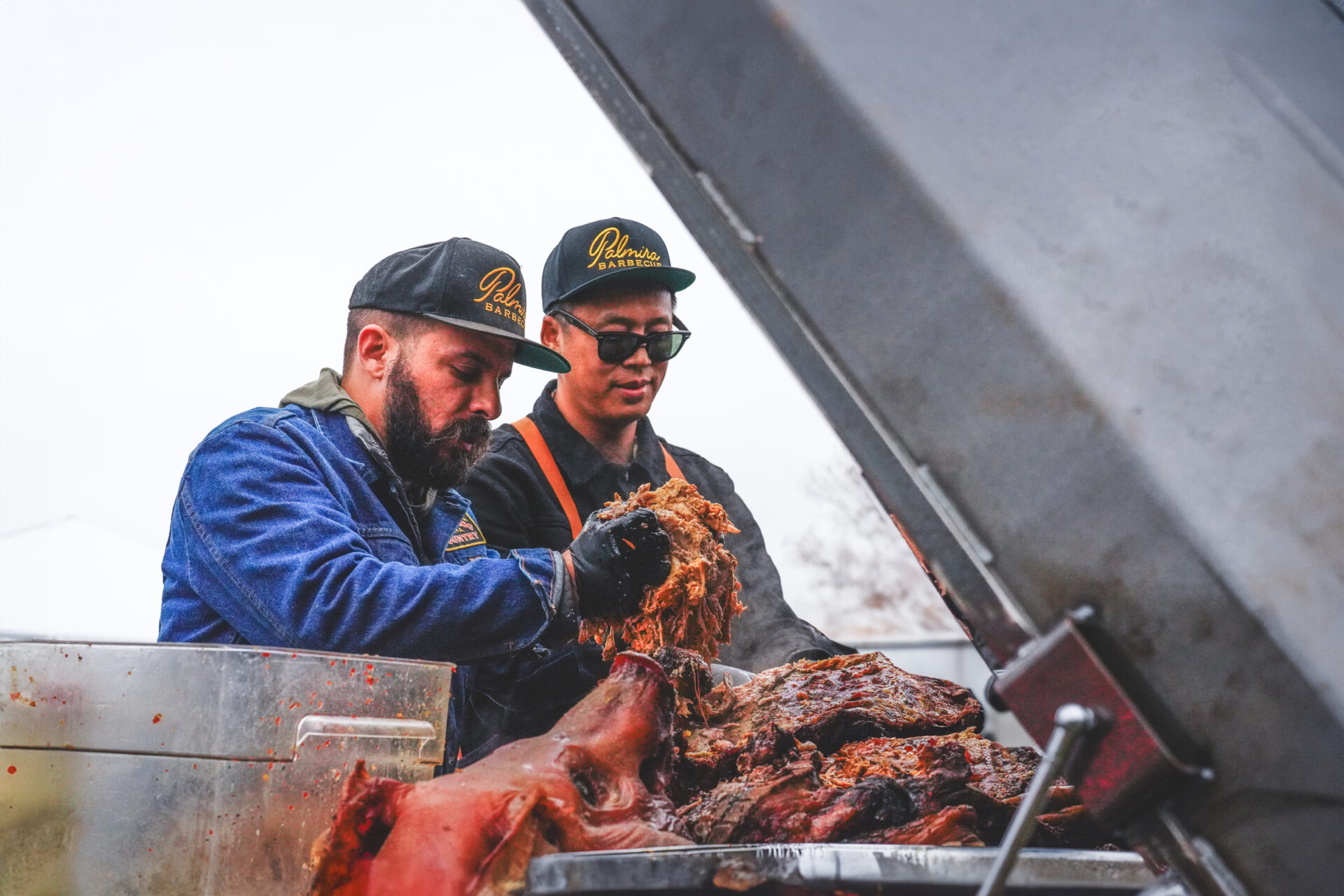
Garate and Nguyen both came to barbecue in their own way. Garate received an offset backyard smoker from his wife several years back and started playing around with Texas-style brisket. He was working in the restaurant world but not cooking. “Barbecue started to give me a purpose,” he says. He practiced constantly, teaching himself techniques, seasonings, and how to smoke different cuts of meat. He also started to apply his own flavor profile to what he made—his
Puerto Rican heritage had been flavored by adobo spices and sofrito, a marinade made up of onions, peppers, and spices. Blending those into his pulled pork and hash recipes, he realized he was hitting on something different.
In 2021, Garate hosted his first Palmira Barbecue pop-up in Charleston. He had connected with Brady Clark, who runs a creative studio in Texas dedicated to barbecue businesses called Brisket Country—Clark designed Palmira’s brand identity. Don Nguyen was another one of Clark’s clients. Nguyen had reached a sort of celebrity status thanks to a few television appearances, including on the Food Network series BBQ Brawl.
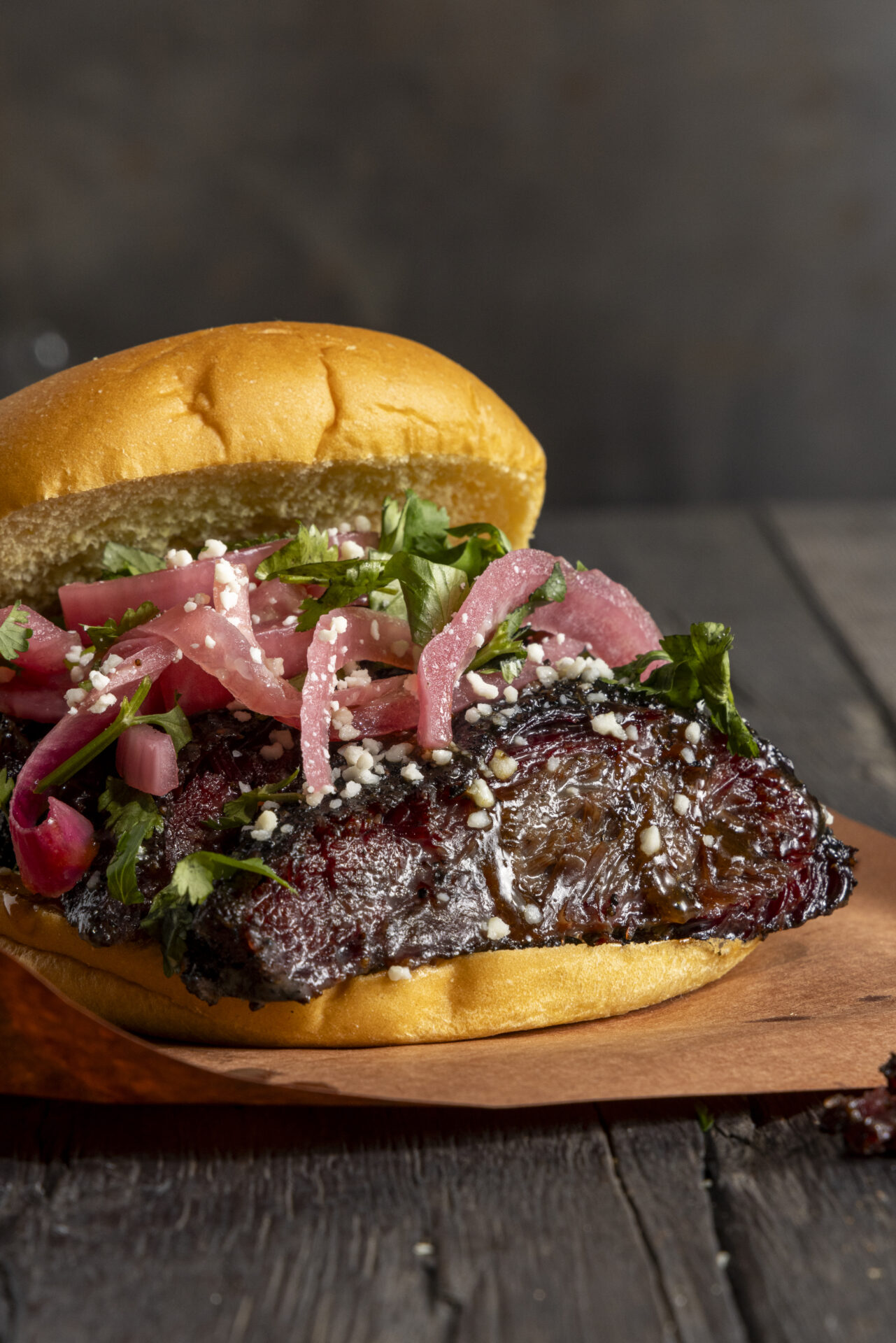
Nguyen was born in Vietnam but arrived in Texas around age 5 and grew up surrounded by his family’s cooking—pho and egg rolls on Sundays—as well as Texas barbecue, with his family eating brisket and beef ribs during trips to Lockhart and Dripping Springs over the years. After military academy and graduating from the University of Texas at Austin (where he first tasted Aaron Franklin’s legendary brisket), he got into barbecue around 2017 thanks to a kamado-style smoker purchased at Costco. He was perfecting his techniques for traditional Central Texas-style ’cue, doing it for fun, until Hurricane Harvey hit, at which point, he pitched an idea to a restaurant friend to sell his barbecue and donate the proceeds to hurricane victims. His pop-ups began in earnest from there, and with time, he started blending Vietnamese ingredients and seasonings into his dishes, adding brisket to his mother’s pho recipe and creating a beef rib nigiri. In 2022, his innovative barbecue landed him on television.
The two Southern pitmasters admired each other from afar, connected through their mutual friend, Clark, but finally met in March 2023 when the pitmaster John Bates invited Garate to do a pop-up at his Austin restaurant, InterStellar BBQ, where Garate would cook a whole hog. But Garate needed a cooker. The offset smokers found all over Texas and the open, direct heat pits that cook whole hogs are two different beasts. So Bates called a person he knew might have the right rig: Nguyen.
Nguyen had cooked his first whole hog on season three of BBQ Brawl. One of the show’s judges was Rodney Scott, the James Beard Award-winning expert on Carolina-style whole hog barbecue. “I’d never done a hog before but I basically just applied the same ideas I’d been using, adding my mom’s flavors to it, like when you have lemongrass pork in a bánh mì,” Nguyen says. The pork turned out well but he didn’t go on to win. He did, however, gain the admiration of Scott.
“It was inspiring, because you’re doing something you’ve never done before in competition in front of millions,” Scott says now. “To approach it the way he did and do as well as he did—it kind of blew my mind.”
It also pushed Nguyen to explore whole hog more seriously. “In Vietnam, I think it’s probably around 80 percent of the meat is going to be pork because beef is really expensive and didn’t really come in until French colonization. So, really refining my technique with hog was a way for me to highlight those Vietnamese dishes and also recontextualize it on an American barbecue canvas,” he says. He built his own cinder block pit and later acquired a fabricated pit from North Carolina to continue his practice.
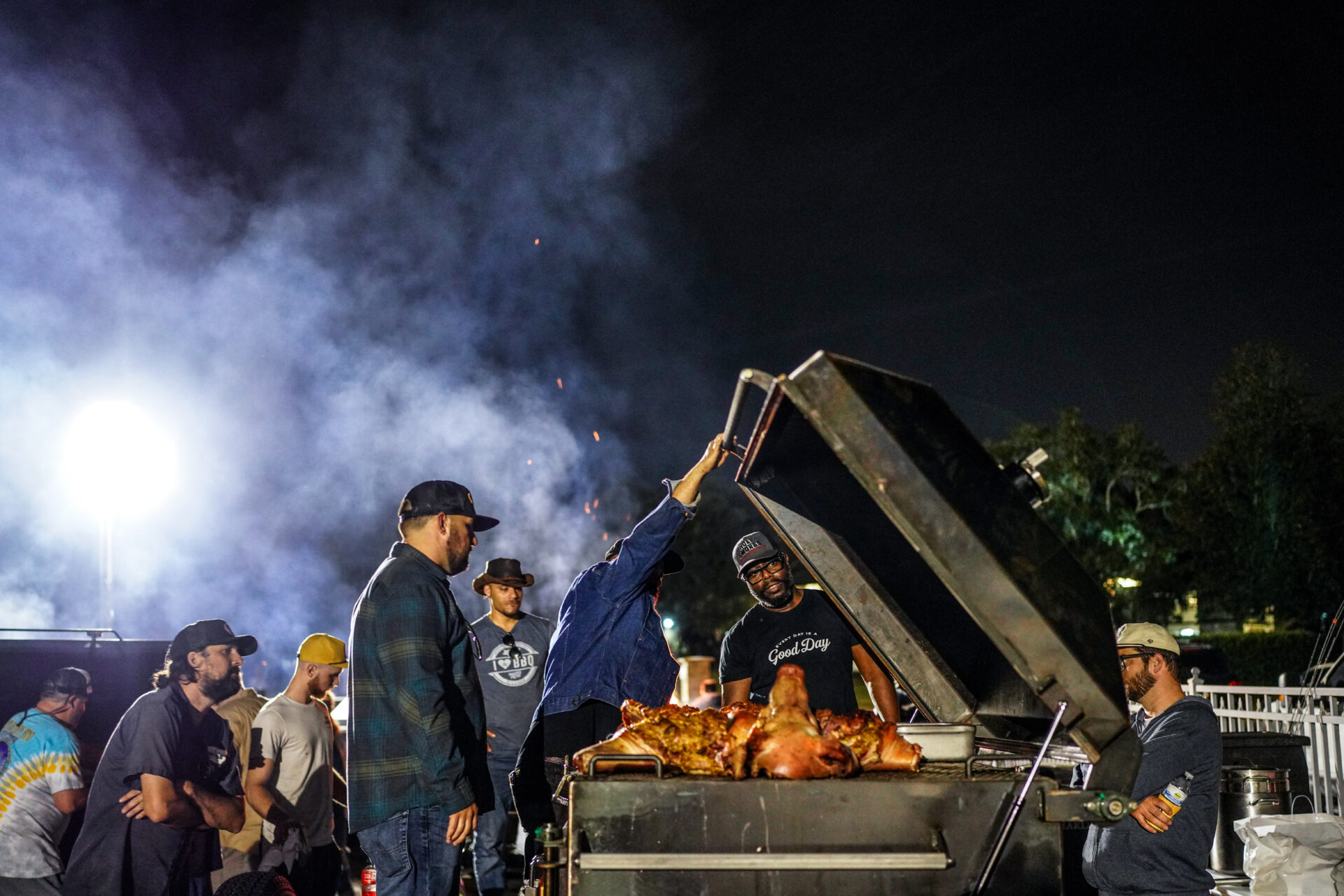
That InterStellar pop-up with Garate cooking on Nguyen’s rig led to another pop-up, this time in Houston as one of Khói Barbecue’s “backyard sessions.” That’s when the exchange between Garate and Nguyen started to flow. Garate once again pulled out his sofrito, cooking down onions, peppers, chiles, and spices to make a marinade for the pork, which Nguyen zhuzhed up by adding lemongrass and fish sauce. Garate shared his closely guarded hash recipe with Nguyen, a sort of sacred passing of the torch. “He’s the only one in Texas doing that true hash,” Garate says now.
Nguyen, whose has a day job in renewable energy and a background in statistics, looks at barbecue from an analytical perspective—he can measure everything from that day’s barometric pressure to the optimization point of burnt coals to determine an end result—as well as an artistic one. Watching Garate work, he became fascinated by the connection between their cuisines.
“I didn’t know that Latin Caribbean cuisine used a lot of the same herbs we do like cilantro, as well as culantro, which we call sawtooth basil and we eat as a topping with pho,” he says. “Through that first experience we found we have a lot in common and a lot more to explore.”
The First Embers
Fifteen ago, when barbecue was hot on the tongues of every food writer in America, most regional styles were not crossing state lines here in the South. Texas barbecue—focused on beef brisket and ribs thanks to the state’s cattle industry—remained rooted there while whole hog was practiced mainly across the Carolinas and Tennessee, where hogs are prevalent.
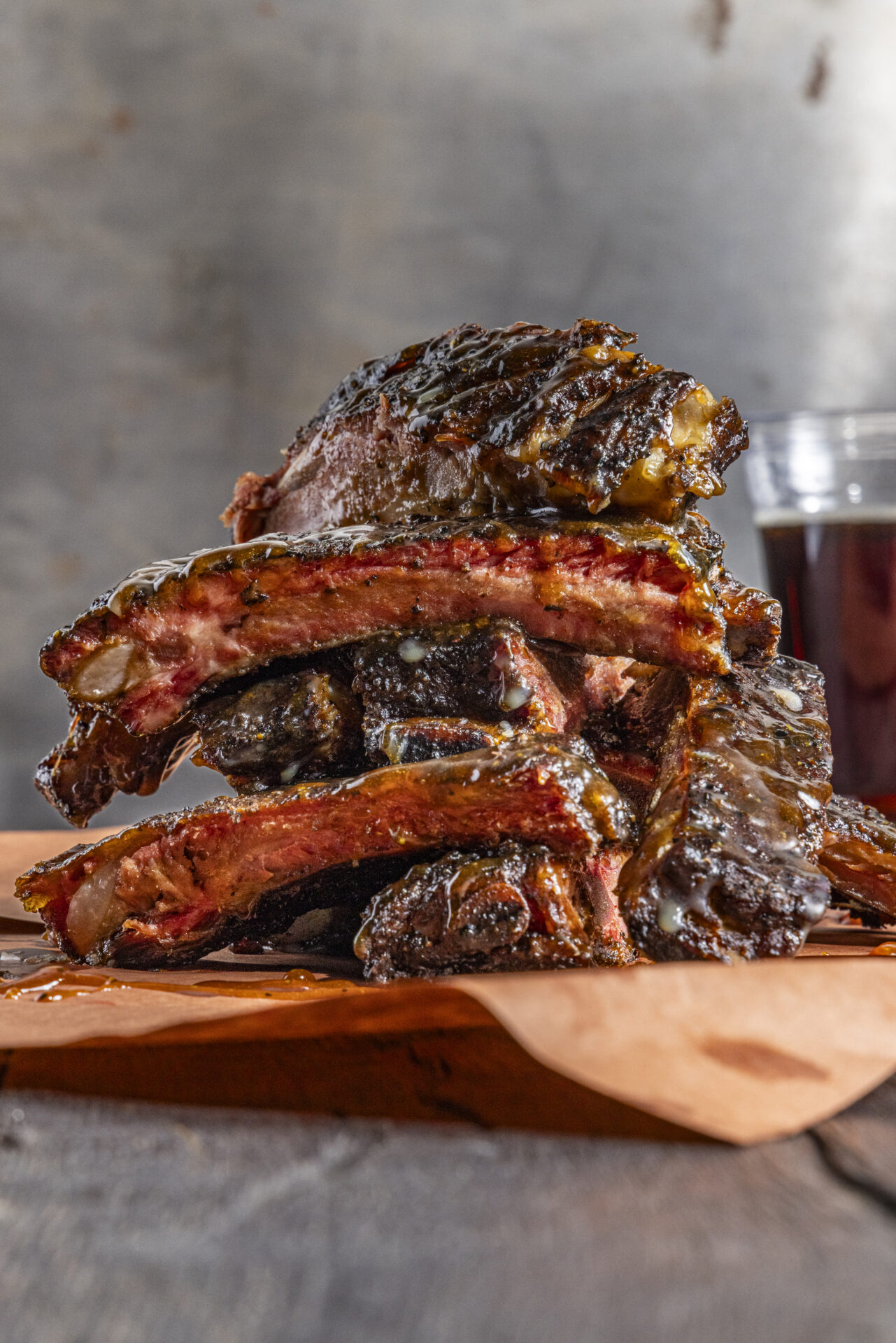
Pitmaster John Lewis, a Texas-raised and -trained pitmaster, moved to Charleston in 2015, being one of the first to carry a regional style with him—he brought his self-constructed offset smoker rigs to the Lowcountry, introducing a new audience to his savory brisket and massive beef ribs. But even before that, in 2014, Houston pitmaster Patrick Feges had taken a chance on whole hog in Texas.
In the early 2010s, Feges and his wife took a road trip through the Carolinas, stopping in Hemingway, South Carolina, to try Scott’s Bar-B-Que, where Rodney Scott was then tending whole hogs at his family’s joint. “It was such a unique, different experience compared to what I was used to having back home,” Feges says. “I mean, that’s the original American barbecue, cooking whole hog over coals. Brisket can be traced back to the 1950s in Texas—it’s our bread and butter—but it’s not that old compared to what the guys on the East Coast are doing. For me, it was an evolution of diving deeper into barbecue history.”
Feges became a student of Scott’s. After watching Scott build a makeshift pit on a barbecue show, he built his own out of 2x4s and metal sheeting. In 2014, he disassembled it and took it over to the second annual Houston BBQ Festival, where he cooked a whole hog for nearly 2,000.
“It was my first pig, which might have been the dumbest thing I’ve ever done. It turned out well and I was happy with it. But to do it for the first time at this big festival for thousands of people? It was pretty ballsy,” Feges says.
He went on to work with Chris Shepherd at Underbelly, where he learned the importance of sourcing locally. He realized one way to work with local purveyors on a sustainable level would be to stay focused on whole hogs rather than brisket. “If you’re doing 10 briskets, that’s five cows. It might work if you have a small-scale rancher,” he says, but found that heritage hogs were more plentiful nearby. After a few more festivals and launching a catering operation, Feges and his wife, Erin, eventually opened their own eponymous brick-and-mortar, which now has two locations. At their Spring Branch spot, Feges is smoking one whole hog per week.
His unknowing mentor, Scott, eventually made it over to Feges BBQ while filming another show. His opinion might just be Feges’ greatest compliment. “For him to admire what I do, and then to do what I do, and to pay respect for it—and then for him to be as successful as he has been in Texas—that has been huge for me,” Scott says. The Carolina pitmaster recognized early that whole hog might be a challenge for some Texans—when he cooked at a barbecue festival in the state in 2015 or so, he recalls two ticket holders coming by and asking him if the pork was actually venison. “They had just never experienced anything like it,” he says.
Daniel Vaughn, meanwhile, argues that today, Texans are ready for it—especially after Garate and Nguyen’s collaboration in Lockhart. “You’ve got this Puerto Rican Vietnamese whole hog barbecue being served in Barbecue City, USA—which seems a little bit out of place. But that’s exactly what people wanted,” he explains. “They wanted to experience something that they might not have had in Lockhart before.”
Stoking the Fire
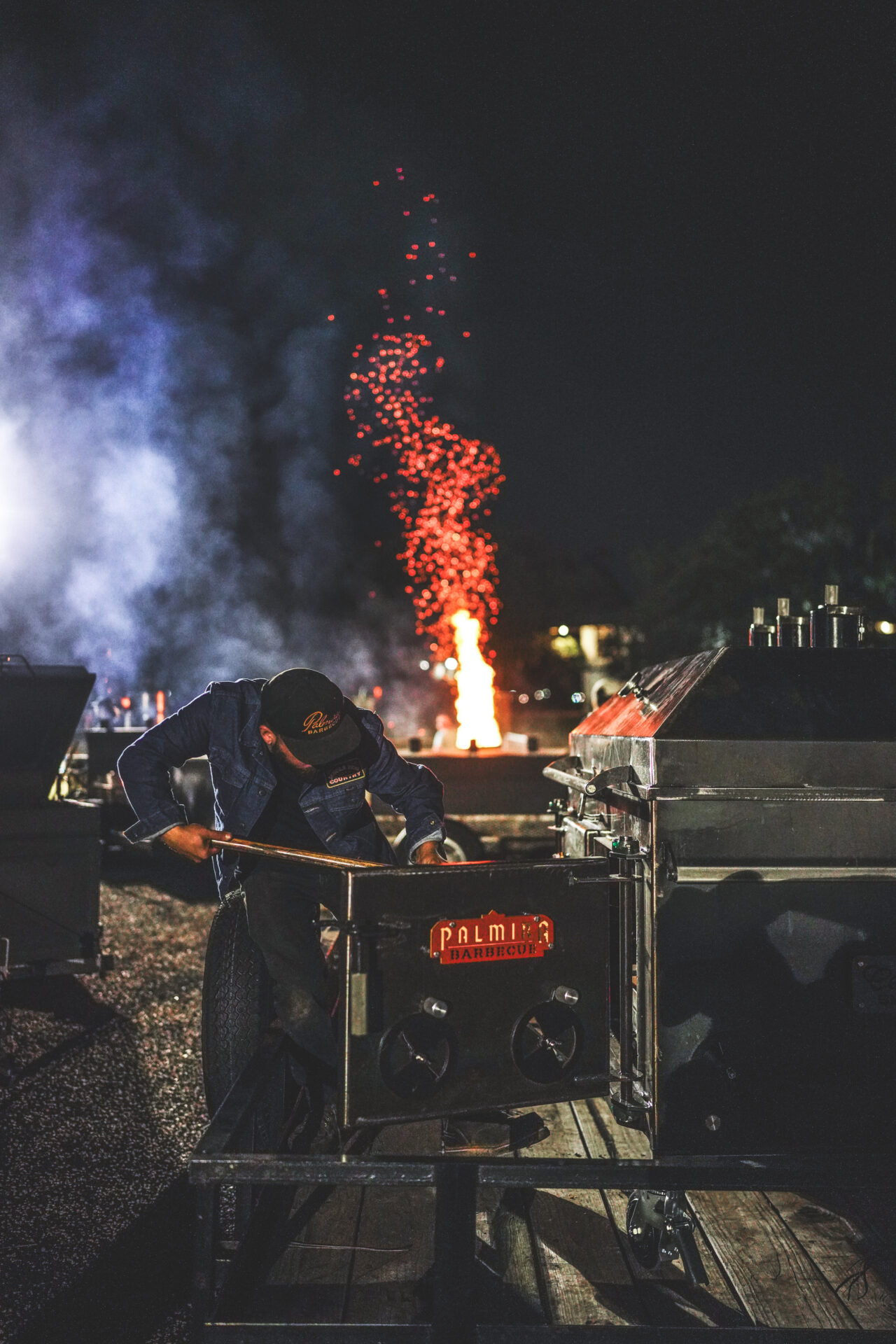
The most notable shift in how Texans are receiving this new trend is in the equipment itself, Vaughn adds. “Five years ago, you were seeing grills and cookers that were built in North Carolina brought over and showing up in Texas,” he says. “But now? We have pit builders here who are building pits specifically designed for cooking over direct heat. That is sort of mind boggling.”
Consider Michael Johnson, one of the bogglers. Johnson started building barbecue pits in 2020, his pandemic pivot. Based in Luling, Texas, just down the road from Lockhart, he grew up on the Central Texas barbecue standards. In 2018, he tasted his first “craft” ’cue at Truth BBQ in Brenham, Texas.
“I just caught the barbecue bug,” he says. Thanks to his father, a welder and fabricator, he’d had some welding experience, and the inspiration he gained at Truth led him to apply those skills to building smokers. The curious maker started talking to pitmasters all over Texas to learn what worked and, more importantly, what didn’t work when it came to their rigs. He filled notebooks with their thoughts and ideas.
A pandemic layoff from his career working in the oil fields gave Johnson the time to get serious. He and his father built a prototype 1,000-gallon offset smoker and found their first buyer: pitmaster Ronnie Killen of Killen’s Barbecue outside of Houston, who was a friend of a friend. “He took a chance on me and luckily it worked out,” Johnson says.
Johnson’s name, and his company, CenTex, got around, and soon, more Southern pitmasters were asking him to commission pits. Today, he and his crew craft anywhere from two to three pits per month.
In January 2023, Johnson attended Smoke & Sunshine: A Craft Barbecue Meat Up in Palm Beach, Florida, where he was introduced to Hector Garate. The two instantly hit it off, with Garate sharing details about the many pits he had fabricated on his own over the years. Back when Garate was starting out, “he didn’t have thousands of dollars to buy a smoker to get started. He was able to do it on his own,” Johnson notes with admiration.
At Palm Beach, Garate cooked on one of Johnson’s offset smokers. He liked it so much, he ordered one to have sent to Charleston. The two kept talking and soon Johnson was on his way to the Carolinas for a barbecue crawl. On that trip, Johnson told Garate, “I think I want to try and build a hog cooker.” They started collaborating on ideas and functionality and soon, Johnson was fabricating his first whole hog cooker prototype.

The debut of CenTex’s first whole hog barbecue pit was in Lockhart, where Don Nguyen and Garate broke it in together. Just one week later, the team carted the pit over to Charleston for the Holy Smokes barbecue festival, where Garate and Nguyen teamed up once again. Rodney Scott was there and spent some time with the two young Southern pitmasters.
“You could taste the difference with Hector’s Puerto Rican influence, and then with Don’s Asian influence. We all stood around talking and it was like, wow. You’ve got the three of us from these three different backgrounds and it all works,” Scott says. “To see them grab this torch and take it to another level—that’s really a good thing for barbecue.”
That first CenTex smoker now lives at Garate’s newly opened Palmira Barbecue restaurant in West Ashley. CenTex, meanwhile, started delivering more whole hog cookers earlier this winter, with both Nguyen and Patrick Feges receiving them in Texas.
With Texas craftsmen now involved in the migration of whole hog into Texas—not to mention the movement of Central Texas-style barbecue now firmly planted in Charleston, thanks to John Lewis—it’s clear that regional barbecue is on the move.
Beyond Borders
On a breezy evening this past March, folks wandered into Palmira Barbecue, Garate’s one-month-old restaurant, and made their way to two long tables set down the middle of the room. Framed photos of Garate and Nguyen from their various meetups hung on the walls, and the space felt more dressed up than its usual counter-service arrangement. Soon, about 50 or so attendees, all part of the Charleston Wine & Food Festival, would fill the room.
Nguyen had arrived several days earlier, and he and Garate had spent every minute prepping for this meal. It would be their first coursed-out, seated collaborative dinner. Right before service, Garate and Nguyen were holed up in the kitchen putting the finishing touches on their dishes. As the guests started to arrive, the two emerged, shyly, almost reluctant to receive the crowd. “We usually do straight-up barbecue,” Garate said with a nervous laugh. “This is fun, too. But not what we’re used to.”
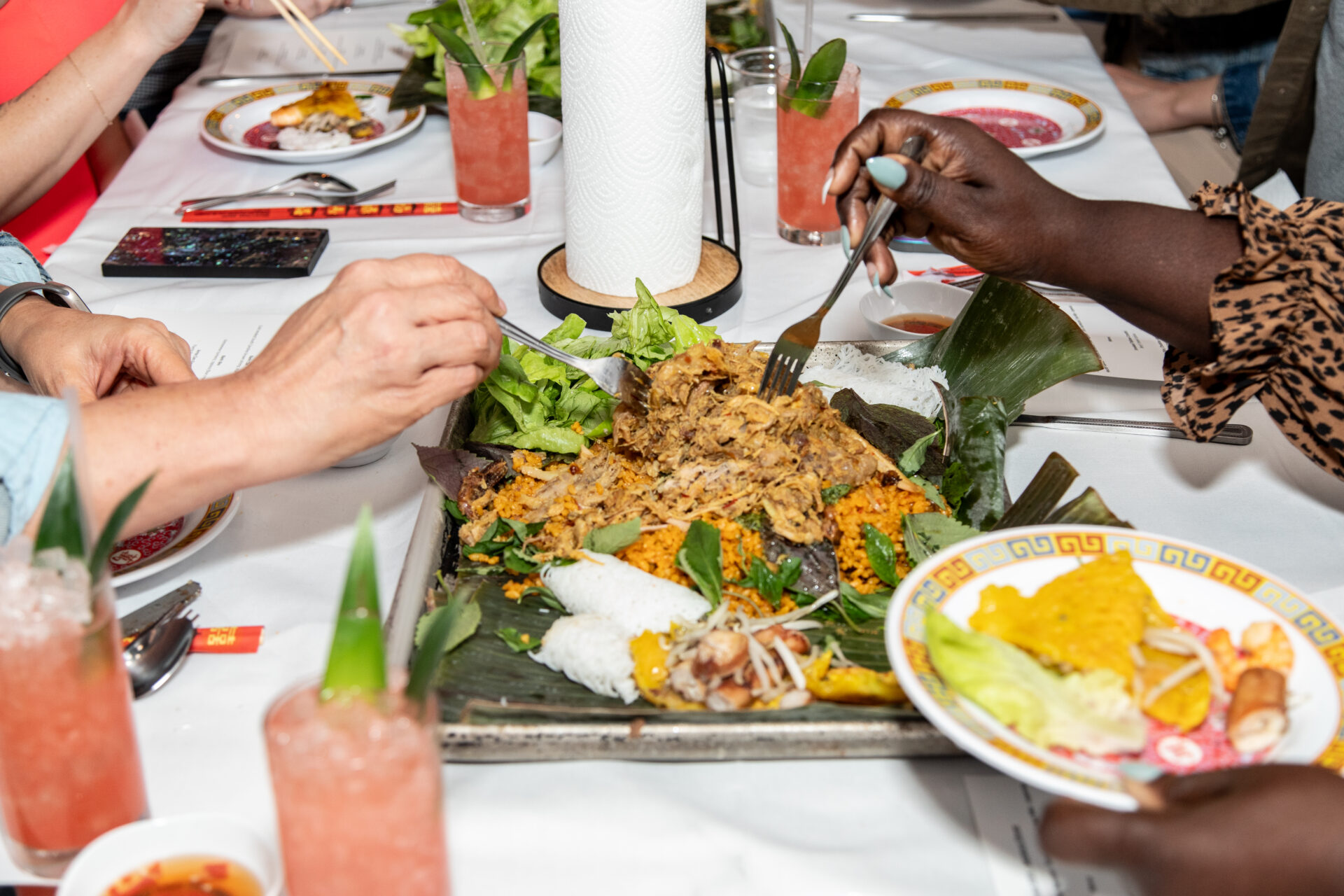
The menu was a true blend of their backgrounds: beef tallow crostini and a pork skewer with a shrimp fritter sitting in a Vietnamese fish sauce. There was a crispy rice cake slathered with Garate’s popular hash (the meat pulled from a pig’s head that had been smoked for 12 hours), the flavors nearly jumping off the plate with sweet and sour headiness.
“We’re here to tell you a story,” Garate explained to the guests during an early interlude. “This is one of my best friends,” he said, nodding to Nguyen. “We approach barbecue like a technique. It’s not about a sauce or a special rub or anything like that. We want to tell a story tonight through our dishes, a story about friendship and also about our origins. Me being from Puerto Rico, Don being from Vietnam. Tonight, we will try to capture and share the essence of what we do.”
It was the showstopper main course that silenced the room. Servers streamed out of the kitchen holding heaping trays of whole hog ’cue. The pig had been smoked for 16 hours before being shredded and torn, marinated in Garate’s sofrito, and layered with Nguyen’s Vietnamese touch. They called it “sovieto-style” barbecue. Huge piles of the pork were served over top of arroz con gandules (rice and peas) along with banh xeo, or Vietnamese crepes infused with turmeric, as well as rolls of vermicelli noodles and a tuft of lettuces.
The guests snapped photos and oohed over every platter, then fell quiet as they started to dig in. Looks of astonished delight and pure joy crossed their faces. The pork was sweet and sour, brimming with smoke but also pepper, umami, and brightness. It was the kind of dish that takes the mind a minute to process. Yes, it was Carolina barbecue. But it was also slightly Caribbean, and the noodles and crepes made it distinctly Asian as well. Smoke, sweet heat, bursts of herbs—every bite tasted like something new.
From Austin’s InterStellar to Lockhart to Charleston, the two have broken down whatever barriers may have existed in the world of Southern American barbecue. Their individual immigration stories may differ wildly, but their passion for carrying their home countries with them is one and the same. By adapting these long-standing regional traditions and adding their own spin, the two are proving that all food travels and all foods evolve—even barbecue.
Keep Reading
At the Table
10 Fresh Barbecue Sides to Upgrade the Cookout
Nine southern chefs share their favorite unconventional barbecue sides ranging from zesty kimchi slaw to rich corn pudding.
Radar
10 Recently Opened (and Soon-to-Open) Restaurants Around the South
Check out these 10 recently opened and soon-to-open restaurants from Miami to Louisville, with Lebanese mezze to rustic Italian food and Spanish vermouth bars.
At the Table
A Barbecue Expert’s Top Tips for Tailgating
Need help with creating the perfect tailgating experience? Michael Letchworth of Sam Jones BBQ has four tips to make it stress free and easy!
share
trending content
-
Our Top 10 Recipes of 2025
by TLP Editors -
Clever Cassoulet With Houston Chef EJ Miller
by Emily Havener -
ShellBound: An Anthology of Southern Oyster Culture | Episode 3: Louisiana
by Maggie Ward -
10 Southern New Year’s Day Recipes to Bring Good Luck
by Emilee Calametti -
Cookbook Review: For the Love of Chocolate
by TLP Editors


